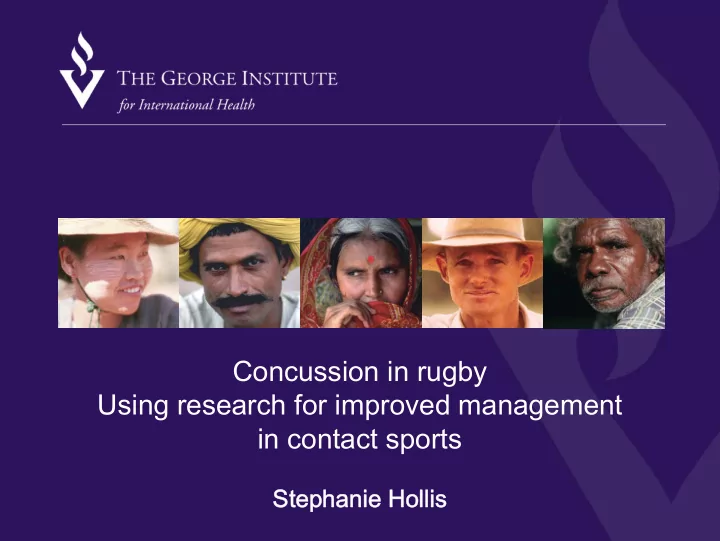

Concussion in rugby Using research for improved management in contact sports Stephanie Hollis
Outline of presentation > Definition of mTBI > Occurrence of mTBI in sport > mTBI in rugby > Aims and importance of mTBI Study > Methodology > Outcomes
Definition of Traumatic Brain Injury a traumatically induced physiological disruption of brain function
Traumatic Brain Injury (TBI) Involves at least one of: � Any period of loss of consciousness (LOC) � Any loss of memory for events immediately before or after incident � Any alteration in mental state at time of incident (e.g. feeling dazed, disoriented, or confused)
Mild TBI (mTBI) � LOC ≤ 30 mins or period of feeling dazed and/or confused � Post-traumatic amnesia (PTA) < 24 hrs � Glasgow Coma Scale (GCS) of 13-15
Concussion = mTBI? A concussion is a mild traumatic brain injury (mTBI) Term ‘concussion’ very loosely used, often associated with LOC
Consequences of mTBI � Prolonged cognitive deficits & resulting symptoms � Increased risk of repeat or recurrent mTBI � Second Impact Syndrome (SIS)
Opportunities for mTBI in sport High incidence rates in contact sports, particularly among the football codes
Rugby Union
Soccer
Rugby League
NFL
Incidence Rates Source: Koh et al (2003) SPORT RISK OF CONCUSSION Soccer 1.3 /1000 Player-Game Hours Karate 1.6 /1000 Athletic Exposures American Football 3.4 /1000 Athletic Exposures Ice Hockey 3.6 /1000 Athletic Exposures 1.6- 9.1 /1000 Player- Game Hours Rugby league Boxing 7.9 /1000 Man-Minutes in Competition Taekwondo 5.1-10.1 /1000 Athletic Exposures
Rugby in Australia � High incidence of mTBI in rugby � Incidence of mTBI in rugby union: 1.84 - 3.85/1000hrs � Largest group of rugby players is the non- elite
Issues for mTBI in rugby � Are players returning to field too soon after mTBI? � Incomplete recovery from mTBI can lead to increased risk of recurrence and serious long term effects No evidence based guidelines exist for � managing return to play decisions � Most research into sport-related mTBI is focused on elite players in various sports
Study aims To: � Estimate incidence of mTBI in rugby players � Examine risk & protective factors for injury and recovery � Examine time to full neurological recovery � Use results to develop evidence-based recommendations for returning players to field
Study cohort 3700 Aust community rugby players (16-35 yrs) Why non-elite? � Largest group of rugby players � Potential higher risk of injury (due to lower level of fitness, technical skills, game exposure, formal training & worse ground conditions)
Study schema INJURED PLAYERS Symptom questionnaire, Recruit neuropsych test <72hr, cohort from 7day, 14day, 21day, 3 Baseline schools, colts month questionnaire, and club (neuropsych test teams in for school teams) Sydney aged 16 to 35 UNINJURED PLAYERS DURING SEASON PRE SEASON PRE SEASON
ImPACT Word Memory Design Memory Colour Recognition Reaction Time
mTBI study outcomes � Incidence o measure of an individuals risk of mTBI � Risk and Protective Factors o headgear o training regimes o position o age
mTBI study outcomes � Time to full intact cognitive functioning post-mTBI � Evidence-based recommendations on management of mTBI
Recent example Dallas Johnson – NRL State of Origin � Returned to play 50mins after mTBI with LOC & PTA Photo: Rugbyleaguelive.com
Study progress � Completion of data collection (Dec 2007) � Dissemination of results in 2008
Key Investigators � Professor Mark Stevenson � Associate Professor Andrew McIntosh � Professor Caroline Finch � Associate Professor Arthur Shores
Collaboration � Critical Care and Trauma Division, The George Institute � Center for Injury Research and Control, University of Pittsburgh � NSW Injury Risk Management Research Centre, and School of Safety Science (RUISS), University of NSW � School of Human Movement and Sport Sciences University of Ballarat � Department of Psychology, Macquarie University
Thank you…
Recommend
More recommend